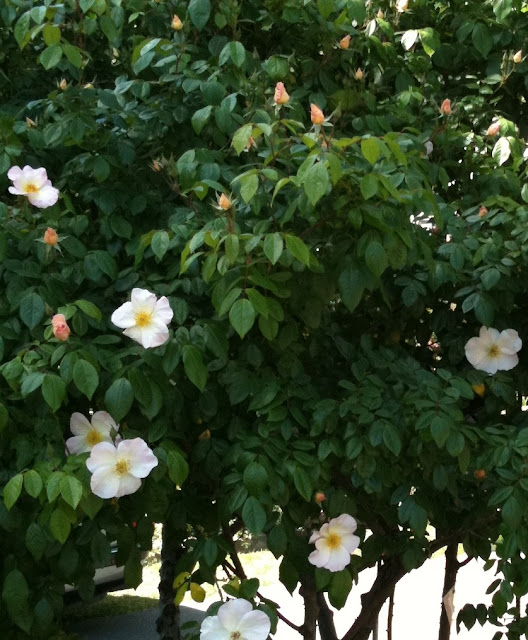...we've got some work to do ... grab your gloves and let's get at it!
Essential Pruning Tools
Leather gloves – invaluable for protection when dealing with thorns!
Pruners – hand-held shearers that can cut up to ¼” stems. Most gardeners prefer by-pass over anvil-styled pruners.
Hedge Shearers – like a giant scissors
Loppers – long-handled pruners, can reach inside rose to cut back the old, dead or diseased canes up to 1 ¼” in diameter.
Small pruning saw – a special gardening saw, you may need if you’ve got some gnarly old rose canes.
A Few Rose Terms
Cane – a rose stem, flexible when new, hardens with age. The really old canes become unlikely to generate new growth (canes, and eventually flowers)
Dormant Stage – comes from latin, dormir, “to sleep” Roses have a hibernation stage in the winter when they stop growing. This is best time to prune them.
Dead Head – removing spent blooms (promotes more blooms - mostly a summertime thing)
Pruning Roses
Whereas all roses will benefit from having dead, diseased or twiggy growth removed, many of the shrub, groundcover or landscape roses can be shaped pretty quickly after that with your loppers. Your hybrid teas, will need a bit more sculpting. The time to prune your roses is before they start to wake up from their winter
dormancy and put out new growth. In the Sacramento Valley and many of the temperate parts of our state, this will best be done between late December and early February. Since the hybrid teas are the most popular roses, and most likely to be in your garden, we're going to concentrate on them.
Pruning Your Hybrid Tea Roses
These roses (like my sister's roses above) will need to be aggressively cut back to 3 – 5 sturdy stems, or canes in the dormant season (now). This will allow a good structure to support new growth in the spring. Here’s how:
If the rose hasn’t been taken care of for a while or still has a lot of leaves on it (like in my California garden), cut everything back to about 3 feet from the ground. This will allow you to see what you’re doing on the next steps. Remove any remaining leaves.
- Cut back any dead canes (branches) to their base.
- Cut back any crossing or rubbing branches (these can create wounds that allow disease to enter) to their base.
- Cut back diseased branches to below the troubled zone. A dark center in the middle of the branch can be evidence of rose borers that have tunneled into your branch.
- Remove any stems smaller than a pencil; those skinny stems will be too floppy to support new growth.
- Choose 3 – 4 canes and eliminate the rest. Don’t cut below your knees, unless you’re going all the way!
- Using a slanting cut (45 degree angle), prune the remaining canes to an outward facing bud, ¼ inch above the bud. These canes will be about 2’ tall.
photo credit: Farmer Fred (Hoffman)
- You don’t need to paint the cuts.
- Clean up all leaves and cuttings and throw in trash, not the compost.
(On the other hand, there's my climbing Cecile Brunner rose, that grows every which way ...over the grape arbor, along the power lines, up the liquid amber. As you can see it's a beautiful display, during its one big hurrah in the spring, after that, it's a wild race to see whose going to win . So far, it's Cecile.)
Caring for Your Roses
The big question: chemicals or organic control? But before that's addressed, the thing to know in life, in your garden, with your body, is that the best defence against illness and disease is being healthy. With plants that means regular water, cleaning up the garden so pests aren't harbored and infection can't spread from diseases in the leaves, mulching to keep soil from drying out (4 - 6" is recommended), making sure you "feed" them (they need their minerals!). Planting they where they get their required daily sunshine and making sure they have good drainage. It's the same with us. Good nutrition, good sleep, exercise, water ... you know the drill. It's the same for our plant friends.
So, to reiterate, what do roses need? Sun (at least 6 hours ... and like many plants in our Sacramento summer gardens, they might like a wee bit of shade in the hot afternoon), regular water - drip is best, make sure you time your system so that the entire root zone gets watered a couple of times a week, good drainage (if your clay soil is really a bog, your roses won't like it, try a raised bed), mulch in your soil so it doesn't dry out. These things will go a long way to prevent diseases and pests from attacking your beauties. And they need some sort of fertilizer, whether organic or chemically based, applied at the appropriate intervals.
As to handling diseases and pests that get by your healthy regimen, there are great organic products as well as natural predators (like lady bugs) that are available at your local nursery, and there are chemical-based products that combine fertilizers with pesticides as well. I'll be adressing this subject in the spring, as well as as identifying the most common rose problems. But, you've got enough right now to get started.
Have fun in your garden... it's almost spring!
Want More? In case you missed it ... here are the links to the other 2 parts of this series on roses in the Sacramento Valley:
Part 1, an introduction, and
Part 2, where we discuss types of roses, great rose retailers, public rose gardens and some useful online resources. Hope this is useful in some way. Feel free to call me if you have any questions, or would like some in-your-garden help.
Whether you need garden design, coaching, seasonal maintenance or planting, Geno's Garden can help!
Call me at (916) 764-5243, or email hansonja@aol.com.























